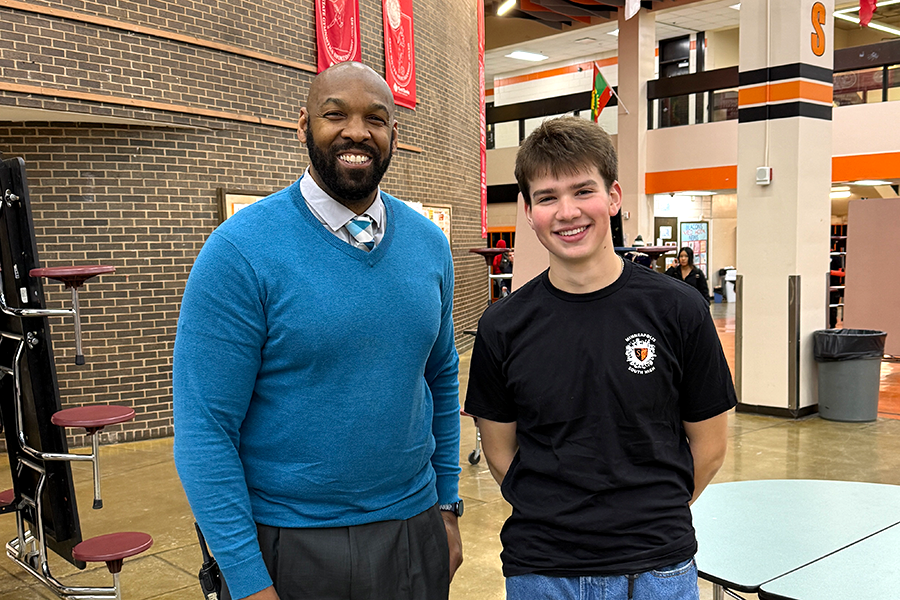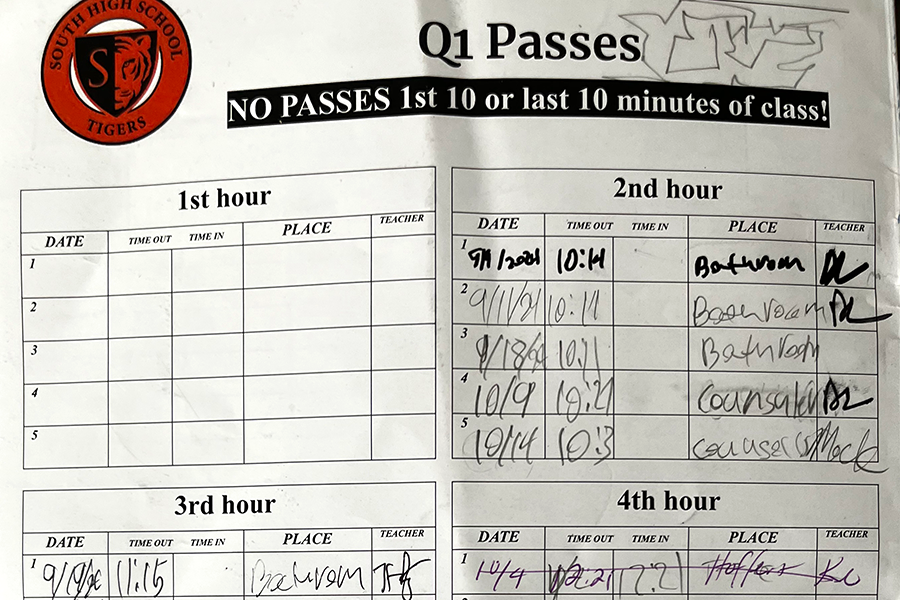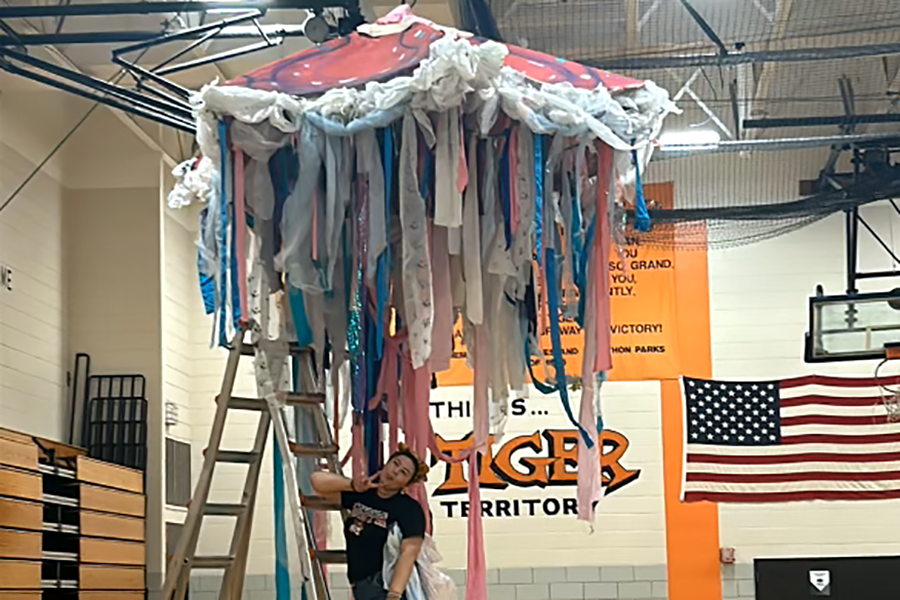Chants of “Idle No More” filled the auditorium and hall as an estimated 700 students marched out of South this Monday, March 11, at 10:30 am. The walkout followed an event that included traditional dancing, drumming, smudging, and student speeches, and was organized to raise awareness for the All Nations program.
Idle No More All Nations grew from concerns within the All Nations community that their rights and culture were being pushed aside by the larger South population.
Senior Winona Vizenor turned these feelings into action by organizing what was originally a walkout and protest outside of the building over Facebook. After discussions with the administration, she agreed to bring the demonstration inside the building to involve the entire student body.
“We want to show the school what exactly we’re about,” Vizenor explained. “We’ll speak for other cultures… It’s time that we come together.”
Idle No More was organized with concrete concerns in mind. Besides feeling underrepresented within South, student speakers demanded the return of drumming, smudging, and events to share their culture with other students. Roughly 600-700 students were at the event in the commons and auditorium, and the events were electronically streamed to other classrooms.
Danielle Grant is the Director of Indian Education for the Minneapolis Public Schools. She attended the event as an observer.
“I’m very excited, as the Director of Indian Ed, to see the students taking a leadership role here. Listening to them is what I’m here to do today,” Grant said. “This is student-led, student-driven, and I’m really here to just support them and listen in every way.”
“One of the goals for today is really to have a positive, unifying event where everyone in the school has the opportunity to learn about All Nations and what their issues are, and moving forward so we all support each other,” Grant explained.
Junior Kai Peterson not only came to the event, but also shared his ideas in a speech and brought a homemade sign. “My sign says Equality for Everyone because the All Nations program isn’t exactly getting equal treatment to the other programs, and a lot of their culture isn’t being accommodated.”
Carmen Mayen-Eagle is a senior in the All Nations program. She has seen the quality of the classes decreasing in her years at South. “From when I was a freshman until now it’s lost a lot of culture. We had a lot of cultural field trips, we did a lot of culture activities, we drummed and we smudged without it being any problem.”
Both drumming and smudging were featured as main parts of the ceremony. The event started at 9am with performances by the Hoka Hey drum group, a local band that also works with the Indian Center running a drum and dance program for kids.
They played six songs, accompanying youth Lady Shawl and Grass Dancers, some as young as eight and eleven years old. Students surrounding the musicians also participated in a round dance.
“We’re here today to represent Idle No More for the All Nations program, fighting for the kids’ rights,” said Dana Nyman, a drummer from Hoka Hey, “you know for their schooling, for their culture, bringing it back to them, because that’s what they need.”
Return of drum circles to South is one of the main demands of the students organizing the event. Senior Symone Brown is in Liberal Arts, but fully supports All Nations in their efforts. “This school is a very musical school, and the fact that their drumming is taken away, what is that saying, ” Brown questioned.
During one of the Hoka Hey songs, students were of fered the opportunity to try smudging and asked to take their glasses and hats off. Smudging is an important tradition in Native cultures involving the burning of sage, and cleansing to clear your head or turn around a bad day. According to Vizenor, students were asked to stop smudging during the school day after complaints that it smelled like marijuana, a claim that Vizenor refuted strongly.
District officials and South administrators at the event addressed these demands made by students, and promised to implement changes.
 Among these changes are bringing people into the school to lead drumming, designating a room for students to smudge on a daily basis, and allocating more funding to organize a pow wow.
Among these changes are bringing people into the school to lead drumming, designating a room for students to smudge on a daily basis, and allocating more funding to organize a pow wow.
Along with these immediate changes, Principal Cecilia Saddler is hopeful that other progress is being made. “The conversation around cultural awareness is alive and kicking,” explained Saddler. “Students are talking about the legacies they want to leave.”
Prior to the events surrounding the protest, Saddler explained that students have already been working through discussion to address issues within learning curriculums. “Cultural awareness goes with having a quality education… I know that the teachers support that as well,” said Saddler. “I would never say that there’s not work to be done at South.”
However, according to the students who followed Vizenor out of the front door, these changes are not enough. Midway through student speeches reports were received via text that students were not being allowed into the auditorium when it was promised to be an event for all.
Vizenor riled the crowd by questioning administrators about what was happening on stage and asking the audience if previous actions were enough. After responding with an emphatic “no,” students left the building amid noise and bustle.
Students that left were not allowed back into the building, and received unexcused absences for the rest of the day. At the beginning of the outdoor protest the crowds marched in the streets around the school building, but what was supposed to be an all day demonstration disbanded early.
Motivations for walking out varied among students. Some, like junior Fatuma Abdi left to support the cause.
“I am here because I know that things need to change and no one’s listening to us,” Abdi explained. “This is how we show that this matters to us and without people listening to us this is how we show this is a big deal to us.”
Others, however, left just to get out of class, leaving organizers and passionate participants angry and disappointed.
“I think it takes away that there’s people who just don’t care about what’s happening and just want to get out of school,” said junior and All Nations student Sean Buehlmann. “People just left the school and went home. Nobody cares about what’s happening.”
Some teachers at South were also confused and frustrated with organization of Idle No More, seeking more clarity from participants.
“I think it would have been better for us to hear some context for what the protest was about in the first place and why it wasn’t enough to have those demands met,” said English teacher David Rathbun.
Rathbun also mentioned the effect the event had on the school day. “A lot of teachers sacrificed what they were doing for the day,” he stated, “a number of us [teachers] changed our curriculum in that we had about 24 hour notice. A lot of the teachers just dropped their plans for Monday and tuned into the protest.”
Despite challenges in planning the Idle No More, students and staff were left hopeful for change in the community.
“[I hope for] more culture embedded into the curriculum,” Mayen-Eagle said. “[For] everybody’s culture to be represented and more representation from our culture and for our people. I hope that All Nations gets culture back into it.”
Abdi also looks to the future. “What I want to see come out of this is that the administration finally recognizes that there’s a problem and that we are segregated as a school and that culture needs to be enforced into our school or else nothing will change.”
For one listener, Idle No More represented a future come true. Clyde Bellecourt sat in the second row, all the way to the left, wearing a beaded medallion. Bellecourt is known nationwide as the founder of the American Indian Movement (AIM), which was founded in 1968 to defend and advance the rights of Native American peoples in the U.S.
“This is one of the most diverse communities, one of the most diverse schools, one of the most diverse gatherings I’ve ever seen in my history here living in the Twin Cities area,” said Clyde Bellecourt. “[It was] a beautiful turnout that was here this morning, with all races of humankind here together to start learning more about one another.”
Saddler agreed. “The day started out as fabulous . . . I was really excited and taken by the students participating.”
Both she and Bellecourt looked to the leaders today to bring a more just future. “There’s still work to do, so I have to make sure I’m looking forward,” explained Saddler. “Moving forward with students is the best way to do that.”
“This was just beautiful. What I witnessed here today in my lifetime I never thought would ever happen,” Bellecourt said. “And it’s wonderful to see that because it’s our children and our unborn generations that will benefit from what happened today.”
“I feel that our voices will be heard because we’ve gotten something back that we’ve been desperately missing which was our drumming circle and our smudging,” said Linda Duran, a senior in All Nations, who was inspired by today’s events. “I feel that if we can get this, imagine what else we can do. It’s just great.”








